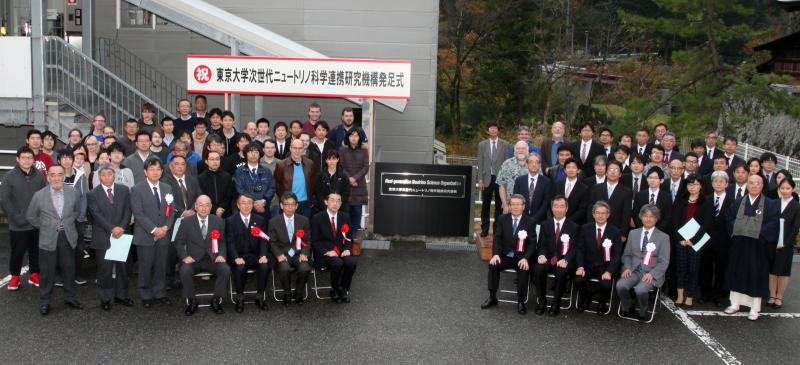Inauguration of Next-generation Neutrino Science Organization for the Hyper-Kamiokande Nucleon Decay and Neutrino Experiment
(Originally published by the Kavli Institute for the Physics and Mathematics of the Universe)
November 10, 2017
Three institutes and university departments, a Nobel Laureate, and a plan to develop one of the world's biggest neutrino particle detectors will be central to the University of Tokyo's newest organization, the Next-generation Neutrino Science Organization (NNSO).
The Hyper-Kamiokande project aims to address the mysteries of the origin and evolution of the Universe’s matter as well as to confront theories of elementary particle unification. To realize these goals it will combine a high-intensity neutrino beam from J-PARC with a new detector based upon precision neutrino experimental techniques developed in Japan and built to be approximately 10 times larger than the running Super-Kamiokande.
On October 1st, 2017, The University of Tokyo launched its “Next-generation Neutrino Science Organization (NNSO),” in cooperation with the Institute for Cosmic Ray Research (ICRR), the Kavli Institute for the Physics and Mathematics of the Universe (Kavli IPMU), and the University of Tokyo’s School of Science. The NNSO is a means of pioneering the future of neutrino physics through the development of neutrino research techniques and detector technologies. In particular, it aims to advance what will become its flagship facility, the Hyper-Kamiokande project. To mark the occasion, an inaugural ceremony was held on November 8th, 2017, at the Kamioka Observatory in Japan.
Professor Takaaki Kajita, director of NNSO and a Nobel laureate for the discovery of neutrino oscillations demonstrating that neutrinos have mass, started the ceremony with opening remarks: “Understanding the neutrino, whose mass is extremely small, is not only important to particle physics, but is also thought to have deep connections to the origins of matter. Indeed, by observing neutrinos created with the high intensity proton accelerator J-PARC at Hyper-Kamiokande and testing whether or not neutrino and antineutrino oscillations are the same, we expect to close in on the mysteries of our matter-dominated universe. Further, we would like to discover the decay of the proton and thereby verify the unification of the three forces that act between elementary particles. Through the research represented by these goals, I would like to greatly expand our knowledge of elementary particles and the universe.”
Professor Masashi Haneda, Executive Vice President of The University of Tokyo and Director of The University of Tokyo Institutes for Advanced Study, greeted attendees with these words: “Through the cooperation of these three important institutions, I’m sure that a world-class center for neutrino research will be established. Further, it will contribute much to cultivate talented young researchers. Succeeding Kamiokande and Super-Kamiokande, the Hyper-Kamiokande project will lead the world’s neutrino research. I would like to underline that the University of Tokyo will do our best to support this newly established organization.”
Professor Hiroyuki Takeda, Dean of the School of Science, also gave an address: “The School of Science has a long and intimate relationship to the research in Kamioka, because Professor Koshiba started the original Kamiokande experiment when he was a faculty member of the School of Science. It is our great pleasure that we can further deepen the relationship with ICRR and Kavli IPMU through this organization to promote neutrino physics and the Hyper-Kamiokande project.”
Professor Hitoshi Murayama, director of the Kavli Institute for the Physics and Mathematics of the Universe, delivered this message: “I firmly believe that the Hyper-Kamiokande experiment will be one of the most important experiments in the foreseeable future to study the Universe. Kavli IPMU would like to contribute to the Hyper-Kamiokande experiment with experimental expertise, theoretical support, and international networking. I'm very excited. Let's make the Hyper-Kamiokande experiment happen!”
Tomonori Nishii, Director of Scientific Research Institutes Division, Ministry of Education, Culture, Science and Technology (MEXT), Japan, presented congratulations: “In July of this year, the MEXT Roadmap 2017, which outlines the basic plan for pursuing large-scale projects, has been compiled by the Council for Science and Technology. It made the implementation priority of such projects clear. “Nucleon Decay and Neutrino Oscillation Experiment with a Large Advanced Detector”, that is Hyper-Kamiokande, is highly evaluated and listed in the roadmap with six other projects. MEXT, together with you, looks forward to seeing this new organization thrive as an international collaborative research hub and produce excellent scientific research achievements.”
The ceremony was attended by about 100 people from MEXT, the University of Tokyo, KEK, local government and community, the Kamioka Mining and Smelting Company, and collaborating scientists. At the end, all attendees got together to take a group photo and celebrated the start of the new organization for promotion of neutrino physics and the Hyper-Kamiokande project.
